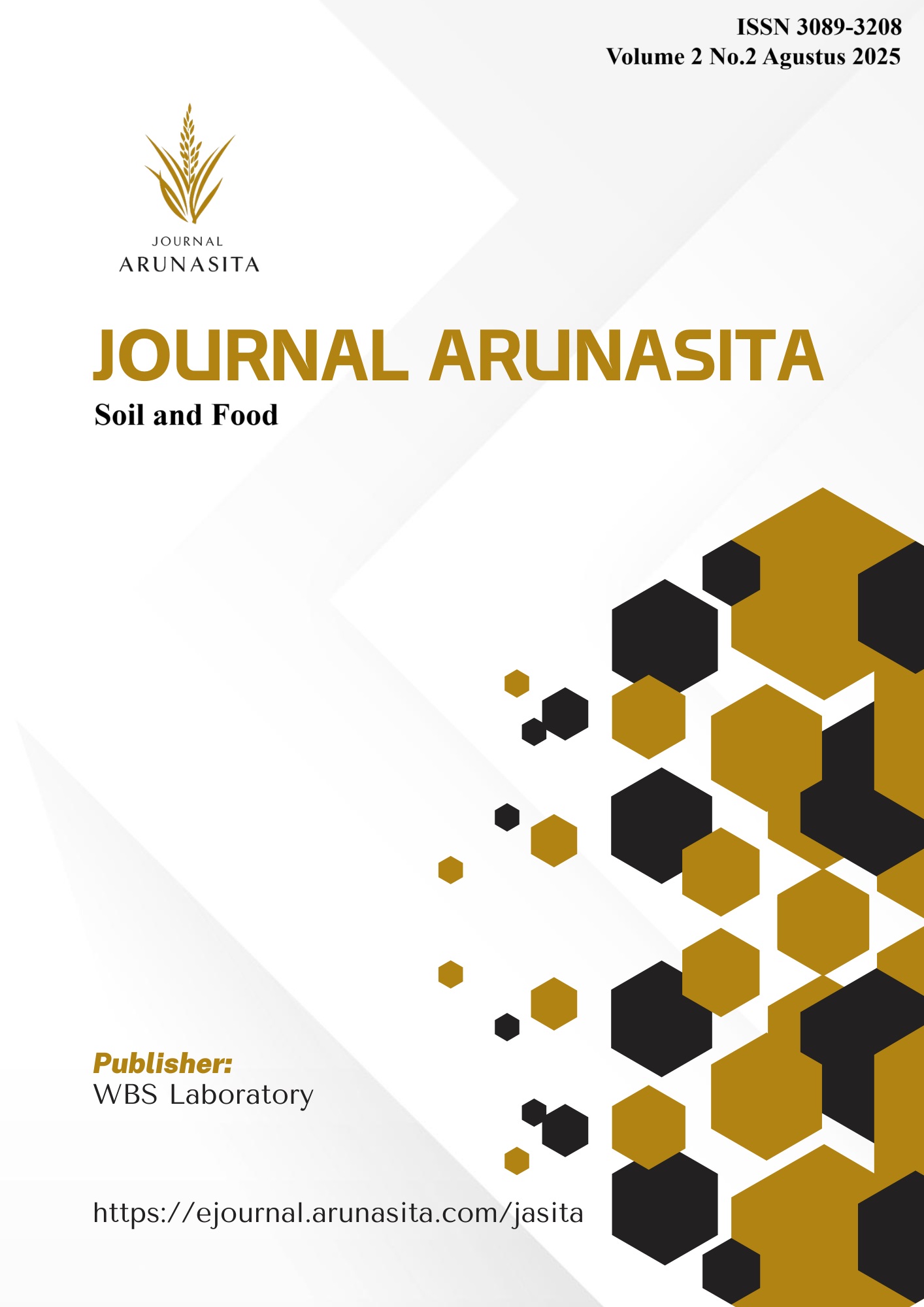Kajian Sifat Kimia Inceptisol Pada Beberapa Kelas Lereng Di Nagari Aie Dingin Kecamatan Lembah Gumanti Kabupaten Solok
DOI:
https://doi.org/10.5281/zenodo.15315593Keywords:
Inceptisol, Slope classes, Soil chemical propertiesAbstract
A study on chemical properties of Inceptisols in four slope classes in scrubland areas was conducted in Nagari Aie Dingin, Lembeh Gumanti Sub-District, Solok Regency, from May 2022 to February 2023. This research was aimed to assess the chemical properties of Inceptisols in several slope classes in Nagari Aie Dingin, Lembah Gumanti Sub-District, Solok Regency. The study was carried out using a survey method. Samples were purposively taken from four slope classes (8-15%, 15-25%, 25-45%, >45%) and one comparison land (25-45%) at depths of 0-20 cm and 20-40 cm with three replications. The parameters analyzed were soil pH, organic C, total N, C/N ratio, available P, and CEC. The research results indicated that the soil pH ranged from 4.61 units to 5.62 units (acidic to slightly acidic). The organic carbon content of the soil ranged from 1.51% to 2.55% (low to moderate). The total nitrogen content ranged from 0.05% to 0.19% (very low to low). The C/N ratio ranged from 9.37 to 35.8 (low to very high). The P-available content ranged from 2.29 ppm to 43.6 ppm (very low to very high). Cation exchange capacity (CEC) had values from 14.28 me/100g to 43.62 me/100g (low to very high). The result showed that in the research area there was a decrease in the value of soil chemical properties along with increasing slope class.
Downloads
References
Agegnehu, G., Bass, A. M., Nelson, P. N., & Bird, M. I. (2016). Benefits of biochar, compost and biochar–compost for soil quality, maize yield and greenhouse gas emissions in a tropical agricultural soil. Science of the Total Environment, 543, 295–306. https://doi.org/10.1016/j.scitotenv.2015.11.054
Atkinson, C. J., Fitzgerald, J. D., & Hipps, N. A. (2010). Potential mechanisms for achieving agricultural benefits from biochar application to temperate soils: A review. Plant and Soil, 337(1), 1–18. https://doi.org/10.1007/s11104-010-0464-5
Biederman, L. A., & Harpole, W. S. (2013). Biochar and its effects on plant productivity and nutrient cycling: A meta‐analysis. GCB Bioenergy, 5(2), 202–214. https://doi.org/10.1111/gcbb.12037
Glaser, B., Lehmann, J., & Zech, W. (2002). Ameliorating physical and chemical properties of highly weathered soils in the tropics with charcoal – a review. Biology and Fertility of Soils, 35, 219–230. https://doi.org/10.1007/s00374-002-0466-4
Ilahi, R. P., Harianti, M., & Sefano, M. A. (2025). Pengaruh Hasil Metabolit Sekunder PSB (Photosyintethic Bacteria) Terhadap Pertumbuhan Tanaman Pakcoy (Brassica rapa L.). Berkala Ilmiah Pertanian, 8(1), 22-31.
Lehmann, J., & Joseph, S. (Eds.). (2015). Biochar for Environmental Management: Science, Technology and Implementation (2nd ed.). Routledge.
Liang, B., Lehmann, J., Solomon, D., Kinyangi, J., Grossman, J., O’Neill, B. & Neves, E. G. (2006). Black carbon increases cation exchange capacity in soils. Soil Science Society of America Journal, 70(5), 1719–1730. https://doi.org/10.2136/sssaj2005.0383
Hidayat, A., Haris, A., & Kusuma, Z. (2020). Pengaruh kombinasi dolomit dan biochar terhadap pH tanah, ketersediaan hara, dan pertumbuhan jagung. Jurnal Ilmu Pertanian Indonesia, 25(1), 45–52. https://doi.org/10.18343/jipi.25.1.45
Novak, J. M., Busscher, W. J., Laird, D. L., Ahmedna, M., Watts, D. W., & Niandou, M. A. S. (2009). Impact of biochar amendment on fertility of a southeastern coastal plain soil. Soil Science, 174(2), 105–112. https://doi.org/10.1097/SS.0b013e3181981d9a
Rondon, M. A., Lehmann, J., Ramírez, J., & Hurtado, M. (2007). Biological nitrogen fixation by common beans (Phaseolus vulgaris L.) increases with biochar additions. Biology and Fertility of Soils, 43(6), 699–708. https://doi.org/10.1007/s00374-006-0152-z
Sefano, M. A., Maira, L., Darfis, I., Yunanda, W. W., & Nursalam, F. (2023). Kajian aktivitas mikroorganisme tanah pada rhizosfir jagung (Zea mays L.) dengan pemberian pupuk organik pada ultisol. JOURNAL OF TOP AGRICULTURE (TOP JOURNAL), 1(1), 31–39. https://ejurnal.bangunharapanbangsa.id/index.php/JTA/article/view/74
Sefano, M. A., Juniarti, J., & Gusnidar, G. (2024). Land Suitability Evaluation For Okra (Abelmoschus Esculentus L.) In Nagari Nanggalo, Koto XI Tarusan District, Pesisir Selatan Regency, Indonesia Using GIS-AHP Technique. International Journal of the Analytic Hierarchy Process, 16(2). https://doi.org/10.13033/ijahp.v16i2.1246
Sefano, M. A., & Gusmini, G. (2024). Efek abu hasil erupsi gunung Marapi dan biochar kulit kopi terhadap perubahan sifat kimia Andisol. JOURNAL OF TOP AGRICULTURE (TOP JOURNAL), 2(2), 102-106.
Sefano, M. A. (2025). Pertanian Berkelanjutan Berbasis AHP dan Multi-Criteria Decision Analysis: Sebuah Tinjauan Kritis. Journal Arunasita, 2(1), 21-34.
Sefano, M. A. (2025). Respon Tanaman Kedelai (Glycine max L.) Terhadap Lama Inkubasi Kapur Dolomit Pada Ultisol. Journal Arunasita, 2(1), 14-20.
Sefano, M. A., Monikasari, M., Auliadesti, V., Nabila, N., Athya, S., Tapiani, W., & Agustian, A. (2024). Pengamatan Sifat Biologi Tanah Pada Beberapa Penggunaan Lahan Di Kebun Percobaan Fakultas Pertanian Universitas Andalas. Journal Arunasita, 1(1), 15-23. https://ejournal.arunasita.com/jasita/article/view/5
Siregar, F. A., Suryani, E., & Azizah, N. (2021). Aplikasi Biochar Sekam Padi untuk Meningkatkan Ketersediaan Air dan Hara pada Tanah Masam. Jurnal Tanah dan Sumberdaya Lahan, 8(1), 25–34. https://doi.org/10.25077/jtsl.8.1.25-34.2021
Subowo, G. (2012). Penggunaan biochar untuk rehabilitasi lahan pertanian dan mitigasi perubahan iklim. Jurnal Sumberdaya Lahan, 6(1), 1–10. https://doi.org/10.2015/jsdl.v6i1.293
Van Zwieten, L., Kimber, S., Morris, S., Chan, K. Y., Downie, A., Rust, J., ... & Cowie, A. (2010). Effects of biochar from slow pyrolysis of papermill waste on agronomic performance and soil fertility. Plant and Soil, 327(1), 235–246. https://doi.org/10.1007/s11104-009-0050-x
Verheijen, F., Jeffery, S., Bastos, A. C., Van Der Velde, M., & Diafas, I. (2010). Biochar application to soils: A critical scientific review of effects on soil properties, processes and functions. European Commission, Joint Research Centre, Institute for Environment and Sustainability.
Xu, G., Lv, Y., Sun, J., Shao, H., & Wei, L. (2012). Recent advances in biochar applications in agricultural soils: Benefits and environmental implications. Clean–Soil, Air, Water, 40(10), 1093–1098. https://doi.org/10.1002/clen.201100738
Yulnafatmawita, Y., & Yasin, M. (2018). Aplikasi biochar dan dolomit dalam mengelola tanah masam untuk peningkatan hasil jagung. Jurnal Agroteknologi, 12(1), 15–22. https://doi.org/10.24843/JAT.2018.v12.i01.p03
Downloads
Published
Issue
Section
License
Copyright (c) 2025 Liza Andini, Teguh Budi Prasetyo, Azwar Rasyidin (Author)

This work is licensed under a Creative Commons Attribution 4.0 International License.





















